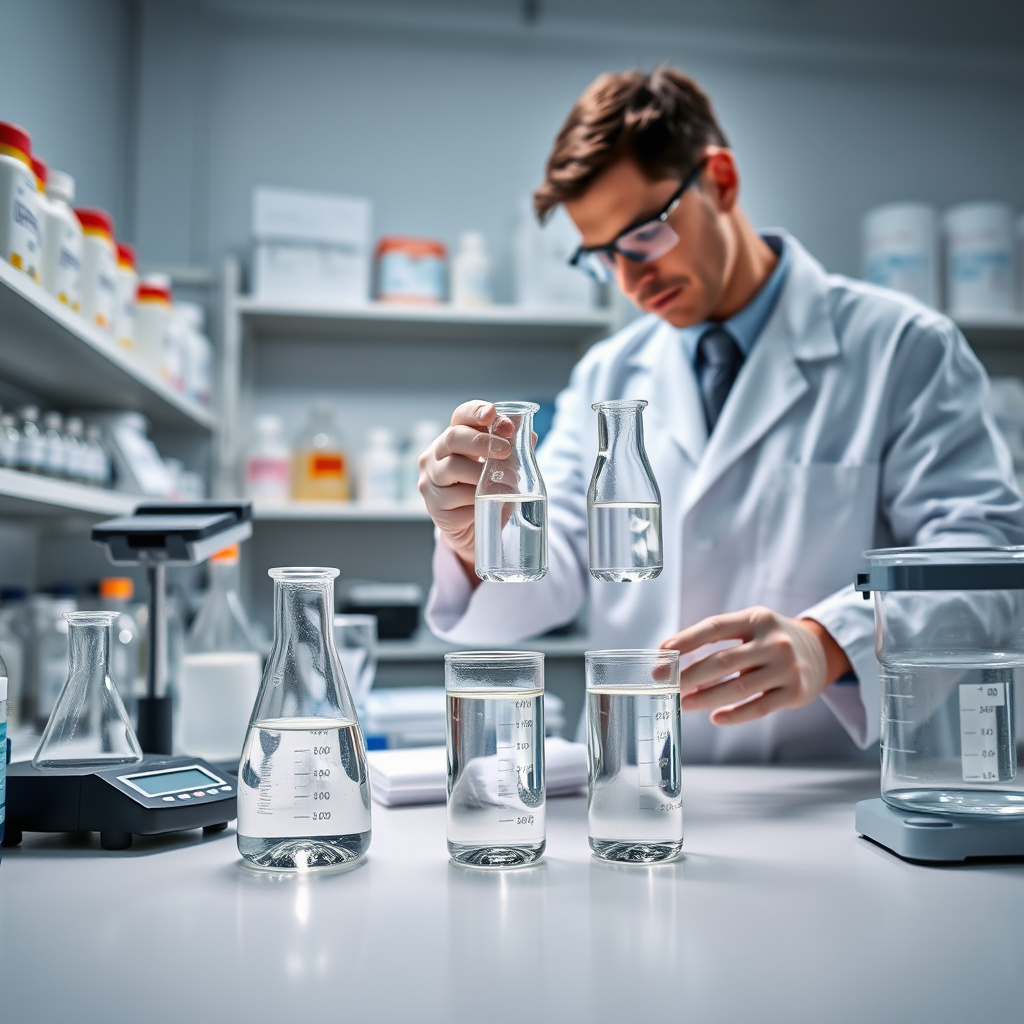Quais são as normas de qualidade para glicerina farmacêutica? Elas incluem diretrizes rigorosas que garantem a pureza, segurança e eficácia do produto.
Quais são as normas de qualidade para glicerina farmacêutica? Neste post, você descobrirá as diretrizes essenciais que garantem a pureza e segurança desse produto vital.
Entender essas normas é crucial para empresas que buscam um fabricante e fornecedor confiável de glicerina a nível global.
A seguir, vamos explorar os padrões que garantem a qualidade da glicerina, ajudando você a tomar decisões informadas e a se destacar no mercado.
Understanding the Importance of Quality Standards in Pharmaceutical Ingredients
In the pharmaceutical industry, the significance of quality standards cannot be overstated. These standards ensure that every ingredient used in medications meets rigorous safety and efficacy criteria, ultimately protecting patient health and well-being. One of the critical components in this landscape is the Glicerina Farmacêutica, which serves various functions, from acting as a solvent to providing sweetness in formulations. The purity and quality of this ingredient are vital, as even minor impurities can lead to adverse effects in patients.
The Role of Quality Standards
Quality standards serve as benchmarks for manufacturers, guiding them in the production and testing of pharmaceutical ingredients. These standards are established by regulatory bodies and are designed to ensure that products are consistently safe, effective, and of high quality. For Glicerina Farmacêutica, manufacturers must adhere to specific guidelines to guarantee that the final product is suitable for therapeutic use.
Why Quality Matters
When sourcing Glicerina Farmacêutica, it’s essential to work with reputable glycerin manufacturers and suppliers who prioritize these quality standards. The risks associated with using substandard ingredients are significant. They can lead to ineffective treatments, increased side effects, and, in severe cases, jeopardize patient safety. Therefore, understanding the quality measures in place is crucial for healthcare professionals and consumers alike.
Key Quality Measurements
Quality standards for Glicerina Farmacêutica typically include parameters such as:
- Purity levels, ensuring that the glycerin is free from harmful contaminants.
- Consistency in production processes to maintain the same high-quality output.
- Testing for specific physical and chemical properties, which are critical for functionality in formulations.
By adhering to these measurements, glycerin sourcing companies can provide reliable products that manufacturers can trust in their formulations. This trust is built on a foundation of transparency and accountability, where suppliers demonstrate their commitment to quality through regular audits and certifications.
The Impact on Pharmaceutical Formulations
The role of quality standards extends beyond just the ingredient itself. The effectiveness of pharmaceutical formulations hinges on the quality of all their components, including Glicerina Farmacêutica. When pharmaceutical companies choose to buy glycerin wholesale from certified glycerin distributors, they are not just acquiring a raw material but investing in the overall success of their products. This commitment to quality ultimately leads to better health outcomes for patients.
In the present landscape, the demand for high-quality pharmaceutical ingredients is more critical than ever. For those involved in the production of medications, understanding and prioritizing quality standards is essential not only for compliance but also for the ethical responsibility of ensuring patient safety. By choosing reputable suppliers and adhering to stringent quality measures, the pharmaceutical industry can continue to thrive and provide effective, safe treatments.
Key Regulatory Bodies Governing Pharmaceutical Glycerin
In the intricate world of pharmaceutical manufacturing, maintaining the highest quality standards is crucial, particularly when it comes to ingredients like Glicerina Farmacêutica. Several regulatory bodies oversee the production, distribution, and utilization of this essential component to ensure that it meets stringent safety and efficacy standards. Understanding these organizations is vital for those involved in the supply chain, from glycerin manufacturers to glycerin suppliers.
FDA and Its Role
The Food and Drug Administration (FDA) plays a pivotal role in regulating pharmaceutical ingredients in the United States. It establishes guidelines that dictate the quality and purity of Glicerina Farmacêutica. Manufacturers must adhere to Good Manufacturing Practices (GMP), ensuring that their products are consistently produced and controlled according to quality standards. This oversight helps ensure that the glycerin used in medications is safe for consumption and effective in its intended purpose.
European Medicines Agency (EMA)
Across the Atlantic, the European Medicines Agency (EMA) similarly governs pharmaceutical ingredients within the European Union. The EMA issues guidelines that must be followed by glycerin production companies operating in Europe. These guidelines cover various aspects, including the sourcing, testing, and labeling of Glicerina Farmacêutica. Compliance with these regulations is essential for companies looking to market their products in the EU, which helps maintain high safety standards for consumers.
International Council for Harmonisation (ICH)
The International Council for Harmonisation (ICH) also plays a significant role in setting quality standards globally. By fostering collaboration among regulatory authorities and the pharmaceutical industry, the ICH develops guidelines that harmonize quality requirements across different regions. This means that glycerin distributors and bulk glycerin suppliers can operate more efficiently, knowing they are meeting internationally accepted standards for Glicerina Farmacêutica.
United States Pharmacopeia (USP)
The United States Pharmacopeia (USP) is another critical authority that sets quality standards specifically for medicines, food ingredients, and dietary supplements. It establishes monographs that define the identity, strength, quality, and purity of Glicerina Farmacêutica. Companies that produce or sell glycerin must ensure that their products comply with USP standards to maintain marketability and consumer trust.
Collaboration and Compliance
For glycerin sourcing companies and those involved in the supply chain, staying informed about these regulatory bodies and their requirements is essential. Compliance not only assures the safety and quality of products but also enhances the reputation of manufacturers and suppliers in the industry. By prioritizing adherence to these standards, companies can effectively meet the demands of the market and contribute to the well-being of consumers.
Essential Quality Parameters for Pharmaceutical Glycerin
In the pharmaceutical industry, the integrity and safety of products are paramount. One of the key ingredients in various formulations is Glicerina Farmacêutica, which serves multiple purposes, including acting as a solvent, sweetener, and humectant. To ensure that this ingredient meets the highest standards, several essential quality parameters must be considered.
Purity and Composition
The purity of Glicerina Farmacêutica is a critical parameter. It should contain at least 99% glycerin with minimal amounts of impurities. Manufacturers must ensure that their products undergo rigorous testing to verify their chemical composition. This purity guarantees that the glycerin will not adversely affect the safety and efficacy of pharmaceutical formulations.
Viscosity
Viscosity is another important quality measure for Glicerina Farmacêutica. The viscosity of glycerin can affect its behavior in formulations, influencing how it mixes with other ingredients and its overall performance. Thus, maintaining an appropriate viscosity that aligns with regulatory standards is essential for ensuring consistency in pharmaceutical products.
pH Level
The pH level of Glicerina Farmacêutica should typically fall within a specific range to ensure stability and compatibility with other ingredients. A pH that deviates from the standard may lead to undesirable reactions or degradation of the final product. Regular testing and monitoring of pH levels are necessary for compliance with industry regulations.
Microbial Quality
Microbial contamination can pose significant risks in pharmaceutical applications. Therefore, Glicerina Farmacêutica must be free from harmful microorganisms. This is achieved through proper sourcing and manufacturing practices, including the use of sterilization techniques. Suppliers play a vital role in this aspect, ensuring that all batches of glycerin are tested for microbial load and safety.
Stability
Stability testing is essential to determine how Glicerina Farmacêutica behaves over time under various conditions. Factors such as temperature, light exposure, and humidity can impact its efficacy. Manufacturers often conduct stability studies to ensure that the glycerin retains its properties throughout its shelf life, which is crucial for maintaining product quality.
Regulatory Compliance
Meeting the standards set by regulatory agencies is non-negotiable for any glycerin manufacturer or supplier. Compliance with guidelines ensures that Glicerina Farmacêutica is safe for use in pharmaceutical applications. This involves adhering to Good Manufacturing Practices (GMP) and conducting regular audits to maintain quality assurance.
Sourcing and Supply Chain Integrity
- Choosing a reliable glycerin supplier is essential to ensure that the quality parameters are consistently met.
- When sourcing bulk glycerin, it is important to verify the supplier’s credentials and their adherence to industry standards.
- Establishing strong relationships with reputable glycerin production companies can facilitate better quality control and reliability.
In today’s competitive pharmaceutical landscape, understanding and adhering to these essential quality parameters for Glicerina Farmacêutica is crucial. By focusing on purity, viscosity, pH, microbial quality, stability, and regulatory compliance, companies can ensure that their products meet the highest standards of safety and efficacy. This commitment to quality not only protects patients but also enhances the reputation of the companies involved in the glycerin supply chain.
Testing Methods for Ensuring Glycerin Quality
In the realm of pharmaceutical ingredients, the testing of glycerin quality is a critical step that ensures safety and efficacy in various formulations. Understanding how to effectively assess this important component can make a significant difference in product reliability. With the increasing demand for high-quality Glicerina Farmacêutica, it’s essential to delve into the robust methodologies employed to maintain these standards.
Physical and Chemical Testing
At the core of glycerin quality assurance are physical and chemical tests. These tests evaluate the purity, composition, and overall quality of glycerin. Common methods include:
- Viscosity Measurement: This assesses the thickness of glycerin, helping determine its suitability for various applications.
- pH Testing: The pH level can influence the stability of glycerin in formulations, making it a vital parameter to monitor.
- Water Content Analysis: Excessive moisture can affect glycerin’s performance, so measuring water content is crucial for ensuring its quality.
Each of these tests provides insight into the glycerin’s properties and how they align with the standards required for pharmaceutical use.
Microbial Testing
Another essential aspect of quality testing is microbial analysis. Glycerin can serve as a medium for microbial growth if not properly sanitized. Testing for microbial contamination involves:
- Enumeration Tests: These count the number of viable microorganisms present in glycerin samples.
- Pathogen Testing: Specific tests are conducted to detect harmful pathogens that could compromise product safety.
These methods are vital for ensuring that the glycerin supplied by manufacturers and distributors is safe for use in pharmaceutical products.
Stability Testing
Stability testing is crucial for understanding how glycerin performs over time under various conditions. This testing simulates different storage conditions to identify any changes in quality. Key aspects include:
- Temperature Variability: Samples are kept at different temperatures to observe any physical or chemical degradation.
- Light Exposure: Assessing how glycerin reacts to light helps ensure long-term stability.
Such tests are imperative for both glycerin suppliers and manufacturers, ensuring that the glycerin remains effective throughout its shelf life.
Regulatory Compliance Testing
Compliance with regulatory standards is non-negotiable in the pharmaceutical industry. Testing methods must align with guidelines set by key regulatory bodies. This involves:
- Documentation Review: Ensuring that all testing methods and results are thoroughly documented and traceable.
- Audits and Inspections: Regular audits of facilities and processes help maintain compliance with safety standards.
For glycerin sourcing companies, adhering to these regulations not only ensures product quality but also builds trust with clients who buy glycerin wholesale.
By implementing these rigorous testing methods, glycerin production companies can guarantee the high standards expected of Glicerina Farmacêutica. This commitment to quality not only protects consumers but also enhances the reputation of suppliers in the competitive market.
The Role of Quality Assurance in Glycerin Production
Quality assurance plays a pivotal role in the production of glycerin, particularly in the pharmaceutical sector, where the standards are exceptionally high. As the industry increasingly focuses on the safety and efficacy of products, understanding the norms related to Glicerina Farmacêutica becomes essential for manufacturers and suppliers alike. This commitment to quality is not merely about compliance; it’s about delivering safe, effective, and reliable products to consumers.
Ensuring Compliance with Quality Standards
Quality assurance in glycerin production ensures that all processes meet stringent regulatory requirements. Regulatory bodies set these standards to safeguard public health, making it imperative for glycerin manufacturers to adhere to them. By implementing robust quality assurance protocols, companies can guarantee that their products consistently meet the necessary criteria for Glicerina Farmacêutica. This includes everything from raw material sourcing to final product testing.
- Raw Material Evaluation: Ensuring that the inputs used in glycerin production meet quality specifications is the first step in the quality assurance process.
- Process Control: Regular monitoring of production processes helps in identifying any deviations that could affect the final product’s quality.
- Final Product Testing: Rigorous testing of the finished glycerin ensures it meets the required standards for purity, consistency, and safety.
The Importance of Traceability
Traceability is another critical aspect of quality assurance in glycerin production. By maintaining a clear record of each step in the production process, glycerin suppliers can quickly identify potential issues and implement corrective actions. This transparency not only boosts consumer confidence but also strengthens the overall integrity of the supply chain. In a landscape where glycerin for sale must meet high-quality standards, traceability becomes a cornerstone of trust and reliability.
Collaboration with Testing Laboratories
To achieve the highest standards in Glicerina Farmacêutica, collaboration with accredited testing laboratories is crucial. These laboratories conduct various tests to assess the quality parameters of glycerin, including its chemical composition and physical properties. By outsourcing testing to specialized facilities, glycerin production companies can leverage expert knowledge and advanced methodologies, ensuring their products are compliant with industry standards.
Continuous Improvement Practices
Quality assurance is not a one-time effort; it involves continuous improvement practices. Glycerin manufacturers are increasingly adopting methodologies such as Six Sigma and Total Quality Management (TQM) to enhance their processes. By regularly reviewing and refining their quality assurance protocols, these companies can respond to evolving regulations and consumer expectations effectively. This proactive approach helps to minimize risks and ensures that Glicerina Farmacêutica remains safe and effective for use in various applications.
Conclusion
In the dynamic landscape of glycerin production, quality assurance is more than just a regulatory requirement; it is a fundamental aspect of a company’s commitment to excellence. For those looking to buy glycerin wholesale or seeking reliable glycerin sourcing companies, understanding the role of quality assurance in the production process is crucial. By prioritizing quality at every stage, manufacturers and suppliers can ensure that they deliver the highest standards of Glicerina Farmacêutica, thereby fostering trust and satisfaction among their customers.
Future Trends in Quality Standards for Glycerin
As the demand for Glicerina Farmacêutica continues to grow, so does the need for stringent quality standards that ensure its safety and efficacy. In the current landscape, the evolution of these standards is not only driven by regulatory bodies but also by advancements in technology and shifts in consumer expectations.
Emphasis on Sustainability
One of the most significant trends is the increasing emphasis on sustainability. Manufacturers are now more focused on sourcing glycerin from renewable resources. This shift is not just about meeting regulatory requirements; it’s about responding to the growing demand from consumers and businesses for environmentally friendly products. Glycerin suppliers are exploring ways to minimize their carbon footprint, which is becoming a key factor in the purchasing decisions of pharmaceutical companies.
Enhanced Testing Protocols
In the realm of quality assurance, enhanced testing protocols are emerging. Current methodologies are being refined to ensure that the Glicerina Farmacêutica meets the highest standards for purity and potency. This involves more sophisticated testing methods that go beyond traditional assessments, including advanced chromatographic techniques and real-time monitoring systems. These innovations not only help in identifying impurities more effectively but also streamline the overall production process for glycerin production companies.
Integration of Technology
The integration of technology is playing a crucial role in the future of quality standards. Automation in production and quality control processes is becoming more prevalent, allowing glycerin manufacturers to achieve greater consistency and reliability in their products. Digital tools and platforms are being utilized for better tracking and documentation, ensuring compliance with regulatory requirements. This is particularly important for glycerin export suppliers, who must adhere to varying international standards.
Consumer-Centric Approaches
As consumers become more informed and concerned about the ingredients in their medications and personal care products, pharmaceutical companies are prioritizing transparency. This trend is pushing glycerin suppliers to provide detailed information about the sourcing and quality of their products. In response, many are adopting a more consumer-centric approach, offering clear labeling and documentation that outlines the quality standards their Glicerina Farmacêutica meets.
Collaboration Among Stakeholders
Finally, collaboration among stakeholders is becoming increasingly important. This includes partnerships between glycerin sourcing companies, regulatory bodies, and research institutions to ensure that quality standards evolve in line with scientific advancements and market needs. By working together, these entities can share best practices and develop comprehensive guidelines that address the complexities of glycerin quality.
The future of quality standards for Glicerina Farmacêutica is undoubtedly dynamic, characterized by innovation and collaboration. As the industry adapts to these trends, the focus remains on delivering safe, effective, and sustainable products to meet the needs of an ever-evolving market.






